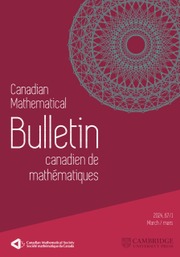No CrossRef data available.
Article contents
On the Boundary and Tensor Product of Function Algebras
Published online by Cambridge University Press: 20 November 2018
Extract
Let  be an arbitrary family of continuous complex-valued functions defined on a compact Hausdorff space X. A closed subset B ⊆ X is called a boundary for
be an arbitrary family of continuous complex-valued functions defined on a compact Hausdorff space X. A closed subset B ⊆ X is called a boundary for  if every
if every  attains its maximum modulus at some point of B. A boundary, B, is said to be minimal if there exists no boundary for
attains its maximum modulus at some point of B. A boundary, B, is said to be minimal if there exists no boundary for  properly contained in B. It can be shown that minimal boundaries exist regardless of the algebraic structure which
properly contained in B. It can be shown that minimal boundaries exist regardless of the algebraic structure which  may possess. Under certain conditions on the family
may possess. Under certain conditions on the family  , it can be shown that a unique minimal boundary for
, it can be shown that a unique minimal boundary for  exists. In particular, this is the case if
exists. In particular, this is the case if  is a subalgebra or subspace of C(X) where X is compact and Hausdorff (see for example [2]). This unique minimal boundary for an algebra
is a subalgebra or subspace of C(X) where X is compact and Hausdorff (see for example [2]). This unique minimal boundary for an algebra  of functions is called the Silov boundary of
of functions is called the Silov boundary of  .
.
Information
- Type
- Notes and Problems
- Information
- Copyright
- Copyright © Canadian Mathematical Society 1966

